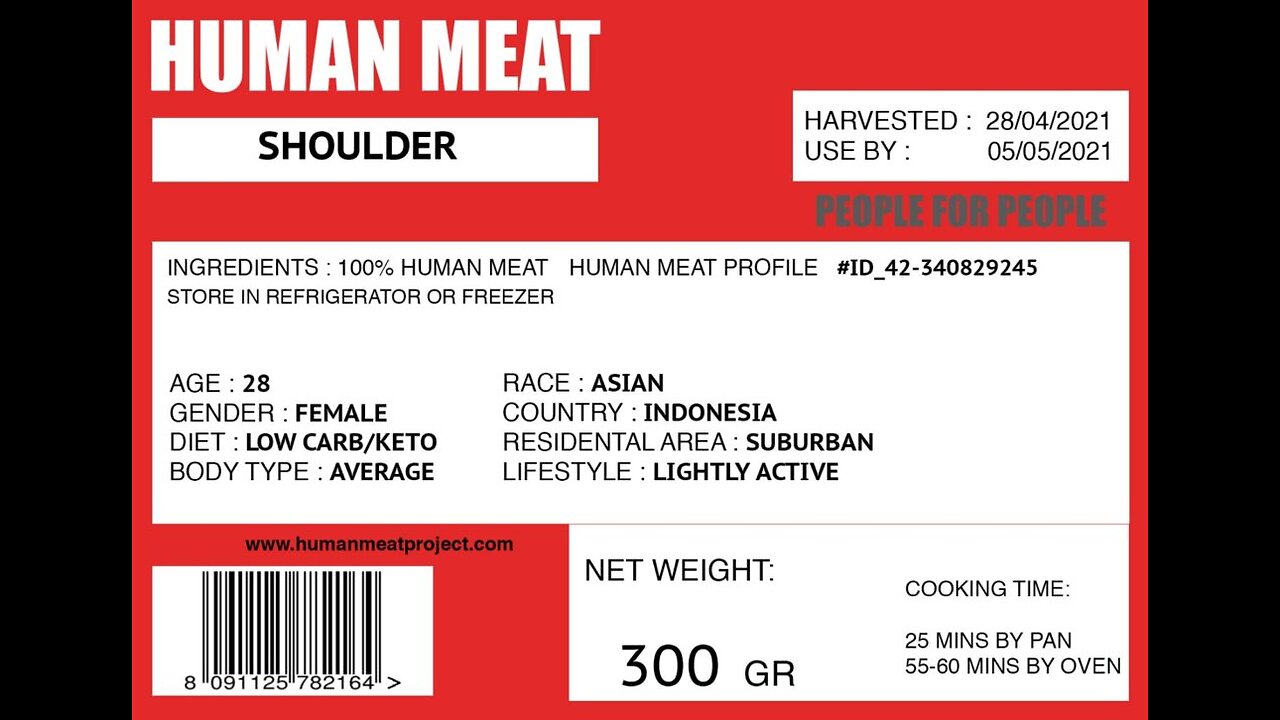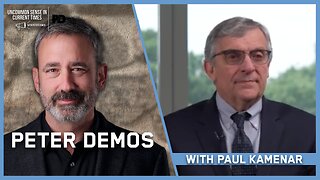Premium Only Content

Human Meat Project - New Shake 'N Bake Fetus - Campbell Cream of Fetus Soup?
Welcome to the Human Meat Project, we are the human meat donation program. By donating bodies for human consumption, we are taking action to solve overpopulation, which leads to climate change and the greenhouse effect caused by the mass farming of livestock animals in order to feed the world. How About A New Shake 'N Bake Kitty Flavors - Like Aborted Fetus ? or Campbell Cream of Fetus Soup If you have a craving for Aborted Fetus Soup, then we’ve got some bad news for you. An Oklahoma Senator, Ralph Shortey, has now outlawed “the manufacture or sale of food or products which use aborted human fetuses.”
DEMOCRATS AND REPUBLICANS COMING TO AMERICA – ‘HUMAN MEAT AND PLASTIC FOOD ? Planned Parenthood Kills Them and Then Sells Their Organs. Which is Worse? Planned Parenthood Is Largest Food Suppliers Human Meat In The World Today. "You Are What You Eat." Most of us have likely heard this saying before and are familiar with its simple and sensible meaning. When we were younger, this adage taught us (hopefully) to take care of what we put into our bodies because the food we eat can have a direct affect on our health as a whole. Selling Human Meat Per Planned Parenthood Rules All Sell At Cost/Lost For Non-Profit Organization.
Federal law prohibits the commercial sell of human meat and trafficking of fetal tissue for profit and carries a penalty of up to 10 years in prison and a $500,000 fine.
(Key Word Is (( 4 Profit )) Per Federal Law and Pedophile's Eating Alive And Aborted Baby and Kids... Is O.K. If Only Sell Human Meat Is At Cost or At A Lost.
P.S. Planned Parenthood Only Sell Human Meat At Cost/Lost... After Paying All Employee Hourly Wages and Other Cost To Run A Not-For-Profit Organization.
Not only must the organization meet the requirements that the state where it is organized sets for non-profits, but it must also meet complex IRS regulations. These regulations are used not only to determine if the organization is exempt from tax under the organization's activities as a non-profit organization.
Cannibalism is defined as the consumption of another human's body matter, whether consensual or not. In the United States, there are no laws against cannibalism per se, but most, if not all, states have enacted laws that indirectly make it impossible to legally obtain and consume the body matter. Murder, for instance, is a likely criminal charge, regardless of any consent. Further, even if someone consents to being eaten and ends their own life, the cannibal may still be liable for criminal or civil actions based on laws governing the abuse or desecration of a corpse, which vary by jurisdiction.
The real threat to our democracy lies in misinformation I am going to take you guys on a real zinger this week. I don’t even know what to say except how thankful I am I don’t eat meat anymore.
I do want to say this in no way implies I think anyone should stop eating meat – pork, cow, deer, chicken whatever you enjoy – but I think everyone is prepared to draw the line at cannibalism.
It’s called The Human Meat Project. If you don’t believe me, check out the website
I actually thought it had to be a joke. You know, a kind of sick satire. So, I contacted The Human Meat Project – I had to know.
No one got back to me from the organization and of course there are no names or any information about where the Human Meat Project is located. Geez, I wonder why they are not listing that information – a bit controversial perhaps.
Remember what I said last week, desensitizing until suddenly the masses think it is okay. I have noticed over the last few weeks more and more people have been talking about this Human Meat Project.
I wonder what the fact-checkers would say about this. Yes, those media fact-checkers who clearly are put in place to “fact-check,” for the most part, to assure those people who do not do more research just believe that the information is a hoax.
Until it’s not.
Didn’t Elon Musk’s new Twitter already prove the fact-checkers might have been a little bit biased in their checking.
And, in one of my columns last month I believe I outlined who owns the companies who are responsible for the fact-checking. Yep, those same companies that own all the media – the dots are connecting more easily these days.
So, let’s get into it – because I think this week the rabbit hole has found a rabbit hole.
At the Human Meat Project website, it explains “The practice of cannibalism is not uncommon in living beings. In both the animal kingdom and our human history, the consumption of one’s own species has existed.”
Well, that is true, but isn’t there enough to eat without eating your buddy next door?
It goes on to outline the human meat donation mission and vision “In order to save the planet from the impact of our modern civilization and lifestyle, we have to make a change in our ideas about consumption and our dietary choices. We face climate change due to waste, pollution, deforestation, and overpopulation problems.
“By donating your body for human consumption, you are taking direct action to help others and lessen the damage of the industrial age.
“By consuming human meat, we create a change in both our life and the world. By improving the standard quality of life in every country and nation, we can give everyone in the world a good life.”
You can read about human meat nutrition facts, and I am going to let you do your own surfing the web for that one, but I will say these project leaders seem very proud that, “one body could feed up to 40 people.”
Does this not just smack of World Economic Forum narrative?
They also go into how they select their donors – “healthy, and without any contagious diseases, health issues, or medications or substances, which might be absorbed by people who consume their meat.”
I wonder if that means those that have been jabbed are not good candidates? Just curious because there are, according to the media, a lot of health issues these days with those that have been vaccinated.
The website states, “donating bodies for human consumption, we are taking action to solve overpopulation, which leads to climate change and the greenhouse effect caused by the mass farming of livestock animals in order to feed the world.”
If you are already dead, how is that contributing to ending overpopulation – since you’re not part of the population anymore?
And finally, there are two YouTube campaigns outlining why this is a good idea. I’m going to just leave this right there.
Next up – some people have requested I check into a restaurant supposedly in Los Angeles called the Cannibal Club. The idea of this place notes the restaurant specializes in “the preparation of human meat” and bringing “the cutting edge of experimental cuisine to the refined palates of LA’s cultural elite.”
The “exclusive clientele” includes noted filmmakers, intellectuals, and celebrities who have embraced the Enlightenment ideals of free expression and rationalism.
Fact-checkers said this was a hoax. I am not convinced, but since there is no address and no information (rightly so because I think human meat might still be on the “no-no” list), it says to get invited you must first introduce yourself through the contact page and they send you information about membership adding, “It is necessary for us to operate privately and to vet our members in order to avoid disruption from the less enlightened.”
And here are a few more foodie tidbits if these aren’t enough to have you running for the hills.
While some people are “dead” convinced (no pun intended) that fast food has human meat in it, I could not confirm or deny – I am still chasing that rabbit hole.
I did find that some people said Pepsi was using the fetal parts of aborted babies as a tested flavor enhancement.
According to a report, around 2001, Senomyx patented several flavor enhancers by using “proprietary taste receptor-based assay systems, which have been previously expressed in human cell culture in HEK 293 cells. HEK 293 cells are a cell widely used in biological and medical research, immortalized through a genetic modification removed from the original human-embryonic kidney cells taken from a healthy aborted human fetus.”
A woman who worked at a clinic said, “We would basically manipulate them into believing that by donating this tissue they could be saving the lives of others, but in reality, we had no idea what that tissue was going to be used for and that was never disclosed to us at the clinic – it was just for a price.”
Apparently, a new ingredient such as this would be labeled under the category of “artificial flavors.”
I think this one requires reader to determine if they want to do their own research. Fortunately, I don’t drink pop anymore, but when I did, I was a Coca Cola girl.
Finally, did you hear about another new food group being created by the FDA and the Department of Agriculture with plastics entering the food pyramid?
The FDA states plastics are a safe alternative to nutrients, and they are excited to introduce plastics to the daily diets of Americans. In a press release from the FDA, it reported “Plastics can be used as an alternative to many of the nutrients found in food such as fiber and protein. Plastics will also help reduce obesity by reducing the amount of food an individual can eat.” What will they think of next?
At Human Meat Project, we value every body and every life at https://humanmeatproject.com/about-us/
We emphasize the source and origins of our human meat to deliver the diversity of our world and reveal the worrying differences of quality of life across the globe.
Our organization welcomes every nation to give back to the rest of the world. Hand in hand, we can help each other improve living conditions and the environment for everyone through this global movement.
We are calling you, humans, to wake up and take action now. We are not living individually and alone. We need each others to survive. Together we can create a world worth living for. Together we can build a world of humanity and solidarity. Every life is cardinal.
Human Meat as Food Source
The practice of cannibalism is not uncommon in living beings. In both the animal kingdom and our human history, the consumption of one’s own species has existed.
During the discovery of the New World, Christopher Columbus brought back what could be seen as early evidence of cannibalistic practices in modern civilization.
The word ‘cannibal’ comes from the name the Spanish gave to the Caribs (Cannibales). The Spanish accused the Caribbean tribe of ritualistically consuming their enemies, but modern-day scholars have doubts that it actually happened. They speculate the Caribs were engaged in an anti-colonial battle with a host of European powers. Many historians now argue that the cannibalism rumors were just a propaganda tactic by the Spanish meant to provoke fear.
The word ‘cannibal’ was used as a derogatory term to describe tribal and native people, and became an indirect ethnic slur.
Human Meat Donation Mission and Vision !
In order to save the planet from the impact of our modern civilization and lifestyle, we have to make a change in our ideas about consumption and our dietary choices.
We face climate change due to waste, pollution, deforestation and overpopulation problems. By donating your body for human consumption, you are taking direct action to help others and lessen the damage of the industrial age.
By consuming human meat, we create a change in both our life and the world. By improving the standard quality of life in every country and nation, we can give everyone in the world a good life.
Human Meat Nutrition Facts
One body can feed up to 40 people*
*An average adult male 65kg, only meat
Human meat often understated for its nutritions, human meat protein and fat density could have the same or better than other convenient meat product like beef, chicken and pork.
As omnivore, human meat taste and texture is similar to pork, not to mention the quality could be more substantial(depending on Quality of Life ratings).
One body contains every essential amino, minerals and vitamins needed for daily intake. Not only one body could feed up to 40 people, it also the most attainable resource for meat and fat consumption.
Quality Control
How we Select our Donors
We make sure our donors are healthy, and without any contagious diseases, health issues, or medications or substances which might be absorbed by people who consume their meat.
Health Risk
Donors who have medical conditions such as AIDS/HIV, Anyone With COVID-19 Shots and Creutzfeldt-Jakob disease (CJD), hepatitis (HAV/HBV/HCV/HDV/HEV), cancer, tuberculosis, or rabies will be rejected in order to prevent risk to the consumer.
There are also other medical condition that might prevent donors from being accepted, such as diabetes, hormone treatments or mental disorders.
Rejected Donation
In case of rejected donation:
If a donor has any medical condition that can be transferred human to human, they cannot be a donor.
If a donor has an active cancer, they cannot donate up until the time the cancer has gone into remission or been removed and will have to wait a minimum of one year after the last treatment or procedure. If a donor has a partial remission, they will have to wait a minimum of one year after the procedure and will go through a medical check up to ensure no medications remain in the body. If a donor has gone through full remission after one year, they can be a human meat donor.
Quality of Life
Quality of Life is a rating system of human meat quality.
Every donor that has gone through our quality control procedure and assessment will be rated based on the quality of their life (health and wellness).
Why Donate?
Over time, the human population has increased rapidly across the globe, leading to a higher demand for food, especially meat products. With this increasing demand, land for residential areas has become more difficult to find and emissions from farms have risen every year, making the lives we lead less sustainable.
We believe that by donating bodies and/or organs we can make a change by creating alternative meat consumption options while addressing the value of a person’s body.
End Date
Sometimes, if a donor is fully committed to donating their body to the society, we can give them an End Date Service. For an End Date Service, a donor can choose any date they want to be harvested.
End Date Services are our way of allowing donors to make important arrangements and have time to live their life up until the date they choose to be harvested. We highly advise meat donors think carefully and discuss with their families before choosing a date.
When the End Date is near, they will be called in for health and physical evaluations. The Human Meat Project will provide spiritual or religious service if the donor is spiritual or religious. The donor is also allowed to call in their personal spiritual or religious guidance. We believe that by giving these services, we can help the donor to have a peaceful death and produce better quality meat.
Privacy
We understand the importance of digital data in our daily life. With advance technology and information expanding rapidly the protection of our sensitive data and identity is a step we must take every time we access any digital platforms or internet services.
In order to keep our donors’ personal(sensitive) information from unwanted parties. Human Meat Project provides ‘Opt Out’ option for donor whom wish to be a private donator.
We, Human Meat Project strongly advised for every one who wish to partake in our cause to read carefully on our ‘terms and condition’ and ‘consent’ throughly.
Opt Out
Every donor can make a choice of ‘Opt Out’ to disclose the followings:
Name - Date & Place of Birth - Gender - Privacy and Consent
The Importance of Meat Label Just like beef from Australia, or USA, or New Zealand and any other countries, Human Meat Project must stated the origins and information for every donated meat and(or) organs to the public. Only ‘Opt Out’ information will be mark as N/A. Every other information a donor has filled in will be shared to the public in our donor list page and listed on the Meat Label.
In every selection the Human Meat Project offers there will be a ‘Quality of Life’ ratings. Quality of Life is based on the physical condition of the most donor’s body, their lifestyle, habit, medical history. The more cleaner a person lives and(or) the healthier their life choices will receive a higher rating.
With this, we are encouraging for future human meat donor to live a better life as well to improve living conditions globally to achieve a high ‘Quality of Life’ ratings.
Before fire did humans eat raw meat?
There is an argument, at least among some scientists, that cooking created humans, rather than the other way around.
The quick answer to your question is that, yes, our predecessors ate raw meat, just like every other carnivore and omnivore on the planet. But those predecessors were very likely not anatomically modern humans. Related, to be sure, but not quite the same as us.
Modern evidence suggests that our ancestors figured out how to make fire a very long time ago. Mastery of fire is generally accepted to have been widespread 125,000 years ago, before the Cognitive Revolution. At least some humans knew how to make fire 200,000 years ago, and some evidence is argued to prove that they had it over a million years ago.
The argument, in essence, is that control of fire allowed our forebears to develop in ways that were previously impossible. The ability to cook food (both meat and other foods), both protects from disease and parasites, and makes a lot more nutrients and calories available for use.
One of the enduring mysteries of human evolution is the human brain. It seems obvious to us that it’s useful for survival, since we’ve spent centuries dunking over every other lifeform on the planet. But, as our brains were developing, it’s not at all obvious that they’d be an evolutionary advantage. Human brains are huge resource hogs, they’re 1–2% of our body mass but consume 20–25% of the calories and oxygen that we use. In a natural, survival-based environment, that seems like a ludicrous waste for minor advantages. Our big brains mean less skull thickness and more weight on our necks, which makes us more vulnerable. They make it harder to pass through the birth canal, which is why human babies are born so early and helpless compared to most other mammals. If you were on the savannah 50,000 years ago, you might be shocked that such misshapen creatures could even survive.
And the process around that is still the topic of debate and discussion, but it’s very likely that we couldn’t have survived in the first place if we hadn’t figured out how to make fire and cook our food. Our ability to do that meant we could get more calories from a given food source, use fewer biological resources on getting sick or fighting disease, and develop more quickly and healthily.
In other words, if our raw-meat-eating ancestors hadn’t figured out how to cook food, it’s likely they never would have become us.
Can a human survive solely on raw food?
Yes. In fact, cooking is a relatively recent phenomenon. The first somewhat well-accepted evidence for cooking comes from the presence of burnt bones and tools at Zhoukoudian, China, between 300,000 and 500,000 years ago in what was probably a very late H. erectus site. Thus, all hominids before a certain date probably ate entirely raw food. ("Hominid Use of Fire in the Lower and Middle Pleistocene" by Steven R. James, Current Anthropology (1989) gives a good, if outdated, review of the origins of cooking and other fire use.) In fact, until recently, there were Inuit groups that went through multiple seasons in a year eating almost nothing but raw, frozen, or fermented meat.
To be clear, though, there have been no modern human populations other than today's raw-foodists who have gone entirely without cooking. Anthropologists like Richard Wrangham use this as evidence that cooking may be an obligatory human behavior, controversially claiming that "people who choose a 'raw-foodist' life-style experience low energy and impaired reproductive function" ("Cooking as a biological trait", Wrangham, 2003).
There are a few disadvantages to not cooking:
Parasites: It's easy to underestimate how big of a problem parasites are, even today. Billions of people worldwide are infected by parasites, many from either unclean water or improperly prepared food. Parasite larvae tend to spend a lot of time embedded in animal tissues (like muscle) and plants, while adult stages will spend a lot of time in animal organs. Infestation with parasites is a major cause of malnutrition and death worldwide, and without proper regulations, transmission through raw food is distinct possibility, while thorough cooking will kill most parasites. The Inuit mentioned above probably have a smaller chance of getting parasites due to the climate, but protozoan and helminth infections were and continue to be a problem among many Inuit. The human digestive tract is resilient, but going for years eating nothing but unregulated raw food will take its toll.
It's hard to eat raw food: Or at least, for a good part of hominid history it was. Early hominids specialized to eat tough plant matter had enormous jaws and huge sagittal crests to attach the powerful muscles needed to grind their food. (To be fair, much of the reduction in jaw size since then was caused by changes in the content of diet rather than the preparation.) Chewing this tough plant material caused many hominids' teeth to be worn down to the gums. (Again, to be fair, much of this was caused by the fact that for a long time, teeth were used as tools, which caused a lot of wear.) These early hominids also probably had digestive tracts better equipped to deal with raw food. The point is that if you are committed to eating raw food, it's not guaranteed that there will always be soft raw food available, and eating tougher food without cooking it takes a lot of effort. Some people believe that cooking has caused such a dramatic reduction in jaw size that it's a major cause of orthodontic malocclusion today ("The adaptive value of dental crowding", A. V. Lombardi, 1982).
To give a dramatic illustration, take a look at the enormous molars on this jaw of P. boisei, a hominid specialized to eat tough plant matter:
In the past, people who ate only raw food would probably have a somewhat shortened life-span due to the disadvantages outlined above. But these are mostly negated by the advantages that modern raw foodists have:
Reduced exposure to parasites: Because of food regulations in the developed world, it's much less likely that you'll get many of the common food parasites than it was before, although you still have to be careful.
Unprecedented access to a variety of foods: Sure, when you're living on the African savannah, living off of raw food may be tough, but in America, we import and grow food from all over the world. Surely, anyone can find enough foods to meet their nutritional requirements and suit their tastes - at least if they're willing to pay enough. And we've developed techniques and foods that make things much easier to eat than the tough plant matter our ancestors used to eat.
Health: I know far too little about raw food diets to make any claims about their health benefits, but practitioners of these diets claim, among other things, that it preserves vitamins and enzymes. (As with any other dietary advice, take the claims with a grain of salt and look at what the evidence says.)
In short, it should be made perfectly obvious that humans can survive on raw food alone, based on the fact that thousands, if not millions, of people have done it and are doing it. Whether or not this is desirable is up to you to decide.
Soylent Green is a 1973 American ecological dystopian thriller film directed by Richard Fleischer, and starring Charlton Heston, Leigh Taylor-Young, and Edward G. Robinson in his final film role. It is loosely based on the 1966 science-fiction novel Make Room! Make Room! by Harry Harrison, with a plot that combines elements of science fiction and a police procedural. The story follows a murder investigation in a dystopian future of dying oceans and year-round humidity caused by the greenhouse effect, with the resulting pollution, depleted resources, poverty, and overpopulation. In 1973, it won the Nebula Award for Best Dramatic Presentation and the Saturn Award for Best Science Fiction Film.
The "Books" conclude from the oceanographic reports that the oceans are dying and can no longer produce the plankton from which Soylent Green is made. This information confirms to Sol Roth that Simonson's murder was ordered by his fellow Soylent Corporation board members, who knew Simonson was increasingly troubled by the truth and feared he might disclose it to the public.
Roth is so shaken by the truth that he decides to "return to the home of God" and seeks assisted suicide at a government clinic. Thorn rushes to stop him, but arrives too late. Before dying, Roth tells his discovery to Thorn. Thorn moves to uncover proof of crimes against humanity and to bring it to the attention of the Supreme Exchange so the case can be brought to the Council of Nations to take action.
Thorn secretly boards a waste truck transporting human bodies from the euthanasia center to a waste-disposal plant, where he witnesses human corpses being processed and turned into Soylent Green. Thorn is discovered, but he escapes. As he returns to the Supreme Exchange, he is ambushed by Soylent operative Fielding and his men. Finding refuge in the church where Simonson confessed, Thorn kills his attackers, but is seriously wounded in a gun battle. As paramedics tend to Thorn, he urges Lt. Hatcher to spread the truth while shouting to the surrounding crowd, "Soylent Green Is People!" Soylent Green Is Made From People!
7 surprising facts about cannibalism white meat is rare and harder to get about 26% and black meat is easy to get about 62% other color's of meat is 12% and Cannibalism can show up at the most unexpected points in history and young human kids meat under 6 yrs. old are best an in fact tastes a lot like veal and human food as meat is sold all over the world.
Most people don't associate cannibalism with the Soviet Union. But as Timothy Snyder describes in his book Bloodlands, the 1933 Stalin-imposed famine in Ukraine was so severe that cannibalism became surprisingly prevalent. The state had to set up an anti-cannibalism squad, and hundreds of people were accused of eating their neighbors or, in some cases, their family members. (Ron Rosenbaum shares many of the gruesome details in a book review for Slate.)
The grisly episode makes vivid the deprivations of the early Soviet era. That many Americans may have never heard of it illustrates another fact about cannibalism — it's something no one ever wants to think about. It's relegated to disgust, tabloid voyeurism, and lame jokes, and those all contribute to a general ignorance of the subject.
Historians and anthropologists, however, have tried to study the history and science of cannibalism over the years: why it happens, when it occurs, and who's affected. It tests the ultimate boundaries of cultural relativism, health, and ritual. Though this list isn't at all comprehensive, it catalogs some of the unusual things about cannibalism you might have missed.
Turns out there are a lot of myths about cannibalism — and how it's been practiced over time. Here are a few surprising things experts have learned:
1) Humans are mostly hard-wired against cannibalism — but not always
There's a good biological reason why cannibalism is taboo in virtually every culture: Eating other humans can make you sick.
Specifically, eating the brain of another human being can cause kuru — a brain disease that's similar to mad cow disease. Kuru occurs because our brains contain prions that transmit the disease. Symptoms begin with trembling and end in death. What's surprising, though, is that this isn't always the case. Among anthropologists, the Fore people in Papua New Guinea are known for cannibalism. Up until the late 1950s, they ate the bodies of relatives to cleanse their spirits. Thousands of Fore contracted kuru and died ("kuru" actually comes from the Fore word for shaking). But not all of them fell victim to the disease: Over the last 200 years, some Fore have also developed a genetic mutation that protects them from the prions that transmit kuru.
The Fore were adapting to cannibalism — with natural selection possibly playing a role in reducing their susceptibility to disease. Scientists have been trying to study this further, but in recent decades, cannibalism has been declining among the Fore because of changing social mores and laws. If that continues, kuru may be wiped out entirely.
2) Animals are mostly hard-wired against cannibalism — but not always
Cannibalism is rare in the animal kingdom — except when it isn't.
A few years ago, Natalie Angier of the New York Times chronicled the tales of the cane toad, caecilian, redback spider, and other animals that eat their own species. The cane toad, for instance, actually prefers cane toad eggs to other options.
How can that possibly be a good idea? Here's Angier: "Researchers propose three motives. The practice speeds up maturation; it eliminates future rivals who, given a mother toad’s reproductive cycle, are almost certainly unrelated to you; and it means exploiting an abundant resource that others find toxic but to which you are immune."
Those evolutionary imperatives extend to a wide range of organisms — even including occasional cannibalistic dalliances from animals like the sloth bear. As Mary Bates described in Wired, it's not unknown for sloth bears to eat members of their own family (possibly because they're under stress).
These human and animal cases are more than curious footnotes. They show that evolution can work in ways that run counter to our cultural values. Evolution happens through natural selection and doesn't always line up with things we might value as a society, and evolved cannibalistic behavior illustrates that important distinction.
3) "Cannibalism" was named after people who might not have been cannibals
A few basic questions about cannibalism are difficult for historians to answer: How many groups practiced cannibalism? When did it start? And how common is it? Those questions are tough because "cannibalism" has been used throughout time to describe many different things. That's also the reason most modern anthropologists and scientists prefer the term "anthropophagy" to "cannibalism."
There are cultures that engaged in cannibalism as a ritualistic practice, but there are also times when people resorted to cannibalism during famine. And at times, the word "cannibalism" has been used to describe all sorts of tactics — and people — seen as savage. Cannibalism is occasionally descriptive, occasionally circumstantial, and occasionally an indirect ethnic slur.
Case in point: The word "cannibalism" itself comes from the name that the Spanish gave to the Caribs (Caníbales). The Spanish accused the Caribbean tribe of ritualistically eating their enemies, but modern-day scholars have doubts that it actually happened. Because the Caribs were engaged in an anti-colonial battle with a host of European powers, many historians now argue that the cannibalism rumors were just a propaganda tactic by the Spanish meant to stir up fears.
On the other hand, we have some evidence the Caribs used body parts as trophies, so cannibalism is a possibility — especially as an intimidation measure or act of war. However, most of our initial testimony comes from Columbus, who had many reasons, both personal and political, to make the Caribs seem as savage as possible.
4) Cannibalistic rituals could be surprisingly complex
One of the first prominent European accounts of cannibals appeared in Montaigne's late-1500s essay Of Cannibals. In addition to being an invaluable anthropological record of the Tupi people in what is now Brazil, the essay sheds light on the intricate practice of cannibalism at the time. Sometimes, the Tupi lived with their captives for months before they were eaten. And they sang to each other.
As Montaigne recorded, the captors taunted captives by "entertain[ing] them with threats of their coming death." And the captives replied in a fashion that was like a song or chant. Montaigne writes:
I have a song composed by a prisoner which contains this challenge, that they should all come boldly and gather to dine off him, for they will be eating at the same time their own fathers and grandfathers, who have served to feed and nourish his body. "These muscles," he says, "this flesh and these veins are your own, poor fools that you are."
Musicologist Gary Tomlinson, who wrote about the Tupi in The Singing of the New World, describes it as an "economy of flesh" that passed through the warring tribes for generations.
"It was a transaction across generations in these warring societies," Tomlinson says. "They were saying, 'In the future, you will be captured by my people, and we will eat you.' The transaction goes on and on."
5) Cannibalism was practiced in Colonial America
Many people might think of cannibalism in distant history and undeveloped countries. But cannibalism was a feature of early American history too.
In 2013, archaeologists revealed they'd found evidence of cannibalism in Colonial Jamestown — an indication of just how desperate early Colonial life had been. Specifically, they discovered markings on the skull of a 14-year-old girl that strongly indicated she'd been eaten by settlers during the particularly difficult winter of 1609.
It was more concrete evidence for something historians had read stories about for years. As Howard Zinn excerpted in A People's History of the United States, one government report painted a grim picture of that winter:
Driven thru insufferable hunger to eat those things which nature most abhorred, the flesh and excrements of man as well of our own nation as of an Indian.
6) The Donner Party wasn't solely about cannibalism
When most people think of cannibalism in America, they probably think of the Donner Party — the famous travelers who resorted to the practice when they were stuck in the snowy Sierra Nevada mountains while traveling west in 1846.
What's surprising, however, is contemporary accounts of the trip focused less on the lurid accounts of cannibalism and more on the breadth of hardship that the party endured. As Donner Party historian Kristin Johnson notes: "Out of the more than 300 newspaper articles about the Donner Party published in 1847, the most common headline is a variation of 'From California' ... a mere seven [headlines] contain the word 'cannibalism.'" Accounts tended to highlight the fact that the party only resorted to cannibalism after eating boiled animal bones, hides, and even a beloved dog, Uno.
What's more, many people were just as interested in legends about the Donner Party's buried treasure as they were in the cannibalism. In the 1890s, a Sacramento newspaper reported that treasure rumors made the people of Truckee, California, "feverish with excitement" and included discoveries that would "delight the heart of a numismatist."
The treasure was probably a myth, but it shows that the story was considered far more complicated — and less purely shocking — than it is today.
7) Cannibalism was sometimes used as a medical treatment
There are many horrifying examples of cannibalism in Europe throughout history. But one of the most bizarre is that cannibalism was occasionally seen as a remedy. To pick one example, in Germany from the 1600s to 1800s, executioners often had a bizarre side job that supplemented their income: selling leftover body parts as medicine.
As described in Kathy Stuart's Defiled Trades and Social Outcasts, human fat was sold as a remedy for broken bones, sprains, and arthritis. Usually, this human fat was rubbed as a balm, not eaten. However, apothecaries regularly stocked fat, flesh, and bone, and there are also examples of a human skull being ground into a fine powder and mixed with liquid to treat epilepsy.
That treatment may sound strange, but remember that eating placenta has become a modern-day health fad. Most of the time, the popular verdict on cannibalism is clear — don't do it. But occasionally, what's cannibalism and what isn't has been surprisingly hard to define.
Human Flesh Looks Like Beef, But the Taste Is More Elusive It’s like pork. Or maybe veal. Even if you have no desire to eat the flesh of fellow humans, it's not so uncommon to wonder from time to time what human flesh looks and tastes like. io9 recently took up the first question and explained that human flesh firmly falls into the red meat camp. Beef, they concluded, would be the closest visual equivalent of a human fillet or rump roast. io9 explains the science behind the color:
Muscle's red color can be traced to the presence of a richly pigmented protein called myoglobin and, more specifically, hemes, the chemical compounds that myoglobin uses to bind and store oxygen as a fuel source for active muscles.
According to the Meat Science section of Texas A&M University's Department of Animal Science, pork, lamb and beef average 2, 6 and 8 milligrams of myoglobin per gram of muscle (that translates to a myoglobin concentration of 0.2%, 0.6% and 0.8%), respectively.
The concentration of myoglobin in human muscle tissues is relatively high – even relative to pigs, sheep and cows, coming in at close to 20 mg per gram of certain muscle fibers, or a 2% concentration of myoglobin.
But, according to the testimony of people who have actually eaten other people, the taste of human meat does not reflect its beef-like appearance. Both serial killers and Polynesian cannibals have described human as being most akin to pork. But not all cannibals agree with this description. William Seabrook, an author and journalist, traveled to West Africa in the 1920s and later described an encounter with man-flesh in great detail in his book, Jungle Ways. Human, he said, in fact tastes like veal. Here's Seabrook's description:
It was like good, fully developed veal, not young, but not yet beef. It was very definitely like that, and it was not like any other meat I had ever tasted. It was so nearly like good, fully developed veal that I think no person with a palate of ordinary, normal sensitiveness could distinguish it from veal. It was mild, good meat with no other sharply defined or highly characteristic taste such as for instance, goat, high game, and pork have. The steak was slightly tougher than prime veal, a little stringy, but not too tough or stringy to be agreeably edible. The roast, from which I cut and ate a central slice, was tender, and in color, texture, smell as well as taste, strengthened my certainty that of all the meats we habitually know, veal is the one meat to which this meat is accurately comparable.
This account is the most descriptive to date, but it has also been called into question. As Slate reports, Seabrook "later confessed that the distrustful tribesmen never allowed him to partake in their traditions." Instead, the author insisted that he attained samples of human flesh from a Parisian hospital and cooked it up himself.
Regardless of Seabrook's credibility, however, Slate points out that, like any meat, the flavor of human would likely depend a great deal on how it is prepared, and also what cut is sampled. The Azande tribe's human stew likely tastes entirely different from the deep-fried, parsley-strewn human genitals a Japanese exhibitionist artist recently served at a dinner party. In the end, both pork and veal might be accurate approximations to the flavor of human meat, though—thankfully—most will never find out for themselves.
How To Cook Human? Cooking human is an incredibly challenging task, and there are many ways to do it wrong. If you’re looking to improve your skills, here are a few tips:
Start with a basic recipe: This is the most important thing—start with something that you know how to make! Try cookbooks or online resources for recipes that are easy and inexpensive to follow.
Use quality ingredients: It’s worth using high-quality ingredients when cooking human. Not only will this result in better results, but you’ll also be able to pronounce the ingredients correctly if you have to share them with others.
Be patient: Cooks need time and patience to get the best results. Don’t give up until your food is cooked through; otherwise, you’ll end up with tough, rubbery meat instead of tender, juicy flesh.
What Part Of The Human Is Best To Eat?
What part of the human is best to eat For many people, it seems that the stomach is the best place to eat. However, there are other parts of the human body that can be very good choices for eating.
How Do You Cook A Human Heart?
Cooking a human heart is a difficult task, but it can be done using various methods. One common method is to cook the heart in oil.
At What Temperature Do Humans Start To Cook?
Cooking at different temperatures depends on what foods are being cooked. Humans start to cook at around 100 degrees Celsius, which is the temperature that is found in most kitchens.
What Human Organ Can You Eat?
If you’re thinking about eating human organs, you might be wondering what kind of organ you can eat. There are many different types of organs that can be eaten, so it’s important to think about what would fit your personal needs and preferences. Here are five human organ recipes that might help get your taste buds working.
What Are Humans Truly Meant To Eat?
Humans have been eating a variety of different things for centuries, but what are humans truly meant to eat? In general, humans are meant to Eat plant-based proteins.
However, some people believe that humans should also eat meat, as it is an important part of human history and culture. There is no right or wrong answer to this question, and it is up to each individual to decide what they believe.
What Does Eating A Heart Taste Like?
Heart disease is the leading cause of death in the United States, and it’s one of the top causes of death in many other countries. There are many ways to prevent heart disease, but some people still get it. In fact, heart disease is the number one cause of death from developing chronic diseases in men and women over 60 years old.
Heart disease can be caused by a variety of things, but the most common cause is cholesterol levels getting too high. Cholesterol is a substance that helps make our body work well.
High cholesterol can lead to heart attacks and strokes, which can kill you quickly. There are various ways to lower your cholesterol levels, but they all come with their own risks.
Can Heart Be Eaten Raw?
Humans have the ability to eat other human organs, but there is currently no definitive answer as to whether or not heart can be eaten raw. There are a few potential reasons why heart could theoretically be eaten raw.
First, because the heart is an important organ in the body, it may be seen as a fair trade when consuming other human organs. Additionally, Heart can potentially taste delicious and may be enjoyed by some individuals for its alluring value.
What Is Human Heart Taste Like?
Human hearts have a unique taste that is often perceived as unpleasant. The reason for this is still unknown, but it could be due to the high level of cholesterol and other lipids in human hearts.
Can You Cook With Human Fat?
Cooking with human fat has been known to give dishes a unique flavor and texture that is often unmatched by other cooking methods. However, some people are hesitant to cook with human fat because they worry it could lead to health problems.
However, cooking with human fat doesn’t need to be a problem – in fact, it can be an incredibly healthy way to cook food. Here are 5 ways you can use human fat for cooking:
Make a healthier version of your current favorite dish – using human fat will add some of the missing flavors and textures that make certain dishes so delicious. For example, adding oil or butter to a dish before adding the human fat will give it a richer flavor and better texture.
What Does Pig Heart Taste Like?
This question has been asked for years, and there is no definitive answer. However, some experts say that pigs have a distinct, earthy taste to their hearts. This is likely due to the pork’s diet being Heavy in animal protein and grains.
How Do I Prepare My Heart To Eat?
Heart health is everyone’s top priority, and it’s important to know how to prepare your heart in order to be healthy. There are a few things you can do in order to help improve your heart health,
including eating a balanced diet, exercising regularly and avoiding smoking. In addition, it’s important to learn how to recognize warning signs of heart disease and take appropriate steps to prevent them from happening.
What Human Can Not Eat?
What humans cannot eat is a topic of much debate. Some believe that what humans cannot eat, they are not meant to eat. Others believe that what humans cannot eat, they should not be able to because it is an essential part of their diet. There is no right or wrong answer to this question, it is up to each individual to decide what they believe.
Is Organ Meat Tasty?
Organ meat is a type of meat that comes from the stomach and intestines of an animal. Some people are very interested in eating organ meat, as it is thought to be some of the most delicious food out there. While there are many different types of organ meat,
there is one that stands out above all others – liver. Liver is a high-quality source of nutrients, including protein and omega-3 fatty acids. It can also help to boost the immune system and provide important vitamins and minerals.
What Can Humans Eat And Not Eat?
What can humans eat and not eat? Humans have been eating and creating their own diets for centuries. For some, this has been a safe way to maintain their health. For others, this has been a way to survive in an ever-changing world. Eating what we can and avoid eating what we cannot is one of the most important decisions we make as humans.
What Did We Eat 1000 Years Ago?
In the past 1000 years, humans have drastically changed their diet. Because of this, archaeologists have been exploring ancient food artifacts to try and learn more about what was eaten back then. While many items have been found, especially in the Old World, there is still much that is unknown about what people ate 10,000 years ago.
One of the most significant changes that humans made to their diet was the addition of animal fats and oils to their food supply.
This led to a shift in how our stomach works and allowed us to eat more protein and other nutrients than we would have otherwise possible. Additionally, due to this change, humans also began consuming a greater number of calories than they currently do.
How Lab-grown meat is made cows, cats, dogs, fish, and human body soylent green -
How Lab-grown meat is made cows, cats, dogs, fish, and human body. The Food and Drug Administration (FDA) on Wednesday announced it has cleared all lab-grown meat product as safe for human consumption for the first time.
In a news release, the agency said that after reviewing information from 100s foods company is making from cultured chicken, cats, dogs. cows and baby cells, it has “no further questions at this time about the 100s firm’s safety conclusion.”
The agency noted that before can bring its products to the market, the facility in which the food is made will have to meet inspection standards from the FDA, the U.S. Department of Agriculture (USDA) and the USDA-Food Safety and Inspection Service (FSIS).
“The world is experiencing a food revolution and the U.S. Food and Drug Administration is committed to supporting innovation in the lab-grown from cows, cats, dogs, baby in are food supply. As an example of that commitment, today we are announcing that we have completed our first pre-market consultation of a human food made from cultured lab-grown from cows, cats, dogs, human baby and other animal cells.”
Eating cats and dog and fish Alive Educational Film ** GRAPHIC ** Green Eggs and Ham -
Asia is the continent on which the consumption of dog meat is most widespread, with as many as 30 million dogs killed for human consumption each year according to estimates by the Humane Society International. This estimate includes many family pets, which are often illegally stolen from their homes and taken to be slaughtered. The consumption of dog meat is said to be most common in China, South Korea, the Philippines, Thailand, Laos, Vietnam, Cambodia, and the Nagaland region in India, but it is not considered widespread in any of these locations. Moreover, the practice is becoming less popular in many countries, where younger generations are more likely to regard dogs and cats as companions rather than cuisine.
Truth Behind Meat Production Chicken Waffle Beef Burger An Eye-Opening Exploration -
Narrated by Oscar-nominee James Cromwell, this powerful film takes viewers on an eye-opening exploration behind the closed doors of the nation's largest industrial farms, hatcheries, and slaughter plants -- revealing the often-unseen journey that animals make from Farm to Fridge. If this documentary moves you, please take a moment to consider if these animals lives are worth taking for merely taste. Thinking about going vegan? The Truth About the Meat Industry
What is left out of our food labels? Behind the cow industry are disturbing secrets you are not supposed to know. Supermarket beef has become an industrialized, unnatural product laced with lies beyond the labels. What actually happens to that meat before it reaches grocery store shelves? In this blog I’ll unveil the dirty truth behind the cattle slaughter process everyone needs to hear.
Pedophile's Eating Alive And Aborted Baby And Young Kids Too Rejuvenating Potion
Planned Parenthood Kills Them and Then Sells Their Organs. Which is Worse? Planned Parenthood Is Largest Food Suppliers Human Meat In The World Today. "You Are What You Eat." Most of us have likely heard this saying before and are familiar with its simple and sensible meaning. When we were younger, this adage taught us (hopefully) to take care of what we put into our bodies because the food we eat can have a direct affect on our health as a whole. Selling Human Meat Per Planned Parenthood Rules All Sell At Cost/Lost For Non-Profit Organization.
-
 5:01
5:01
What If Everything You Were Taught Was A Lie?
27 days agoTrue Mystery Of Tartaria World's Fairs History We've Been Told Us Is A Lie Chicago 1893
6.36K15 -
 6:29
6:29
BIG NEM
22 hours agoCultivating God Mode: Ancient Taoist NoFap Practices
30.5K6 -
 30:53
30:53
Uncommon Sense In Current Times
1 day ago $7.99 earned"Pardon or Peril? How Biden’s Clemency Actions Could Backfire"
50.6K4 -
 40:01
40:01
CarlCrusher
20 hours agoSkinwalker Encounters in the Haunted Canyons of Magic Mesa - ep 4
47K2 -
 59:44
59:44
PMG
1 day ago $5.74 earned"BETRAYAL - Johnson's New Spending Bill EXPANDS COVID Plandemic Powers"
54.9K21 -
 6:48:50
6:48:50
Akademiks
18 hours agoKendrick Lamar and SZA disses Drake and BIG AK? HOLD UP! Diddy, Durk, JayZ update. Travis Hunter RUN
176K30 -
 11:45:14
11:45:14
Right Side Broadcasting Network
9 days agoLIVE REPLAY: TPUSA's America Fest Conference: Day Three - 12/21/24
360K28 -
 12:19
12:19
Tundra Tactical
18 hours ago $13.18 earnedDaniel Penny Beats Charges in NYC Subway Killing
74.5K14 -
 29:53
29:53
MYLUNCHBREAK CHANNEL PAGE
1 day agoUnder The Necropolis - Pt 1
163K67 -
 2:00:10
2:00:10
Bare Knuckle Fighting Championship
3 days agoCountdown to BKFC on DAZN HOLLYWOOD & FREE LIVE FIGHTS!
63.2K3